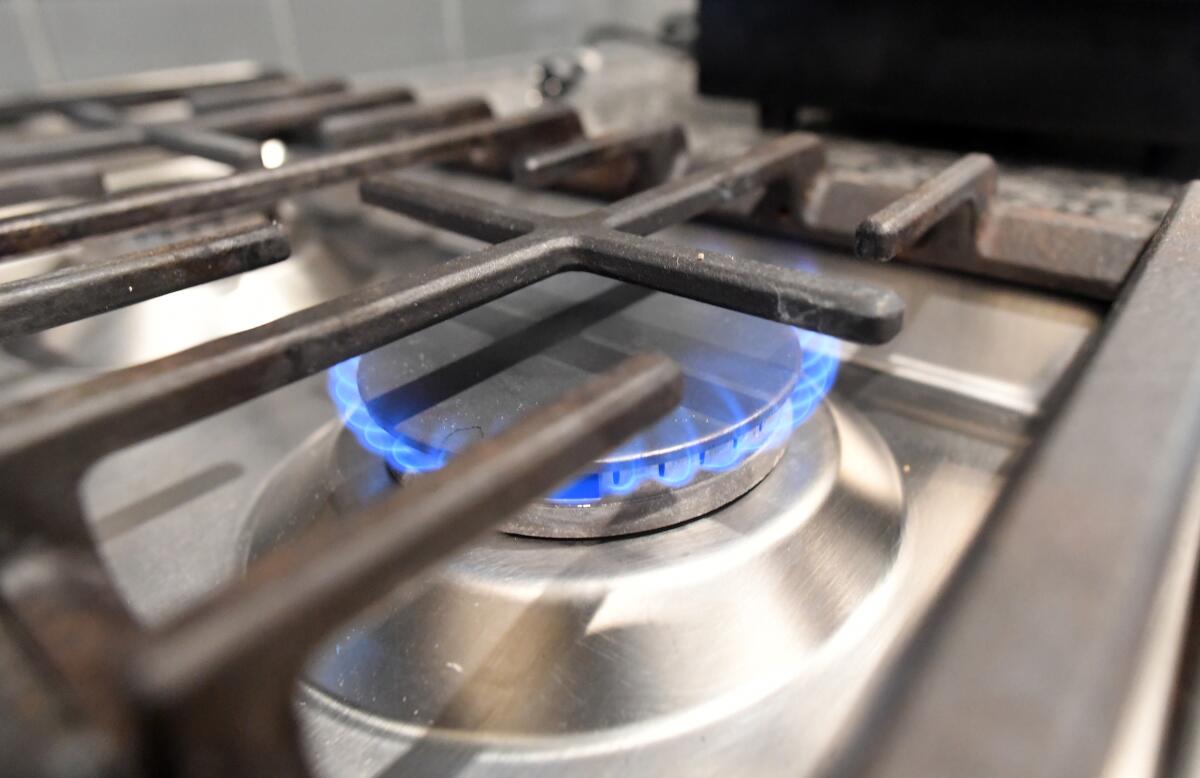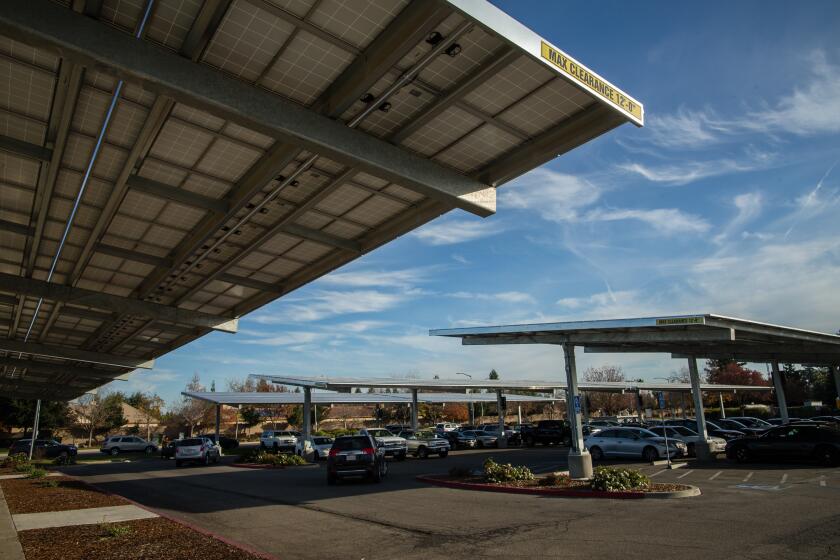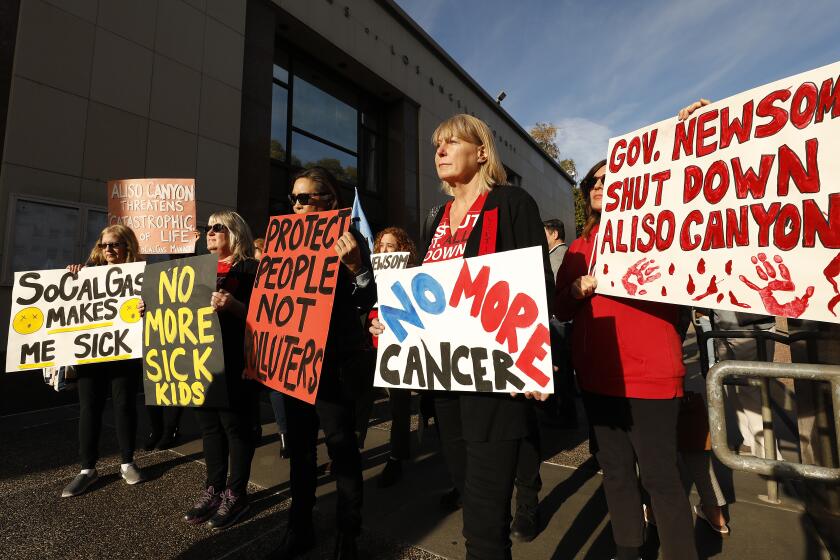Editorial: Los Angeles lags on building electrification. Now is the time to ban new gas hookups

- Share via
Appliances are not as obvious polluters as power plants or diesel trucks, but the gas-fueled stoves, water heaters, furnaces and clothes dryers that predominate in California homes and businesses are a major source of health-damaging and planet-warming emissions. To avert disastrous climate change and protect people’s health, they must be replaced with electric models powered by renewable energy.
Yet natural gas consumption in California homes and buildings has been rising in recent years. And because there has been a lack of leadership at the state level to electrify buildings, the effort to ban gas and change building codes has been left to cities, leading to a patchwork of progress.
More than 50 California cities and counties that have enacted policies to ban or discourage gas hookups in new buildings. Much of the progress so far has been in the Bay Area, where San Jose, San Francisco and Oakland are among the cities that have adopted policies to prohibit gas in new buildings.
California won’t be able to meet its targets at its current pace of pollution reduction. Here are three actions state officials can take in the next year to pick up the pace.
But in Los Angeles there’s been little action since 2019, when Mayor Eric Garcetti released a plan calling for new buildings to be “net-zero carbon” by 2030, and for the entire building stock to be zero-emission by 2050.
Nearly three years later, Los Angeles is finally poised to act.
In recent months, council members have begun the process to get natural gas cooking and heating appliances out of homes and businesses. City officials are pushing to adopt a ban on gas hookups in new buildings by Jan. 1, 2023, though it’s not clear yet how quickly these new codes would take effect. The city wants to start converting existing buildings to electric cooking and heating at the same time it applies electrification rules to new buildings, though many of the details are still being worked out.
But that should not be an excuse to move slowly. Officials should move to phase out gas appliances on an aggressive timeline and make sure that low-income communities of color, renters and others that are hardest hit by pollution and extreme heat receive the benefits rather than the burdens of this shift.
A proposed $9.8-million fine against Southern California Gas Co. is unlikely to deter it from using ratepayer money to derail climate change action.
Electrification efforts have faced strong pushback from Southern California Gas Co., an investor-owned utility that serves the Greater Los Angeles area. It views gas bans as a threat to its business model and has aggressively campaigned against them through astroturfing, or setting up fake community groups, and lobbying. That has not been much of a factor in the Bay Area, where the main utility is Pacific Gas & Electric, which has been relatively agnostic about what fuel source buildings use.
There have been worries among community groups, including the LEAP LA Coalition, that focusing too much on shifting to electric appliances in new buildings, without doing enough to address existing ones, will concentrate air quality improvements and other benefits among those who are able to afford them and fuel housing and environmental inequality. Organized labor has raised concerns about lost pipe-fitting work as homes switch to all-electric heating and cooking. That landscape has surely contributed to a City Council that has been timid and resistant to change.
Meanwhile, the state has been little help. Gov. Gavin Newsom has set no target date for ending the sale of gas appliances — as he has for new gas-powered passenger vehicles by 2035. He has proposed nearly $1 billion to help low-income communities replace natural gas appliances with electric models, but such efforts will be rudderless without clear statewide targets.
Starting with new construction is a logical first step. We cannot keep building homes with outdated gas infrastructure that will only prolong fossil fuel emissions. But building codes that apply only to new units will do nothing to reduce pollution and improve air quality in the vast majority of homes.
Los Angeles should also be moving aggressively to retrofit existing homes with energy-efficient electric appliances like heat pumps, which cool interior spaces in the summer and warm them in the winter, and make communities more resilient to heat waves while reducing greenhouse gas emissions. Gas ranges are also relatively easy to replace with electric induction models.
But water heaters and furnaces are often emergency purchases. Most people don’t replace them until they break down. So it’s crucial that rebates and other incentive programs be seamless and easy for people to switch to electric models when their gas-powered ones fail. Special care must be taken to make these programs work for poor communities that often lack the upfront cash for energy-efficient appliances and electrical panel upgrades, and to ensure that landlords do not pass the costs of retrofits onto tenants.
Los Angeles officials are smart to launch these efforts through an extensive engagement process, including a series of public meetings beginning next month and a commission made up of community members tasked with coming up with equitable policies to eliminate climate pollution from new and existing buildings. Officials should incorporate their recommendations to ensure the burdens of this transition do not fall on tenants or workers. At the same time, city leaders must acknowledge they are getting a late start and need to accelerate their efforts to catch up.
Now that Los Angeles is finally moving to ban gas, it should move quickly, but take care to get it right.
More to Read
A cure for the common opinion
Get thought-provoking perspectives with our weekly newsletter.
You may occasionally receive promotional content from the Los Angeles Times.












